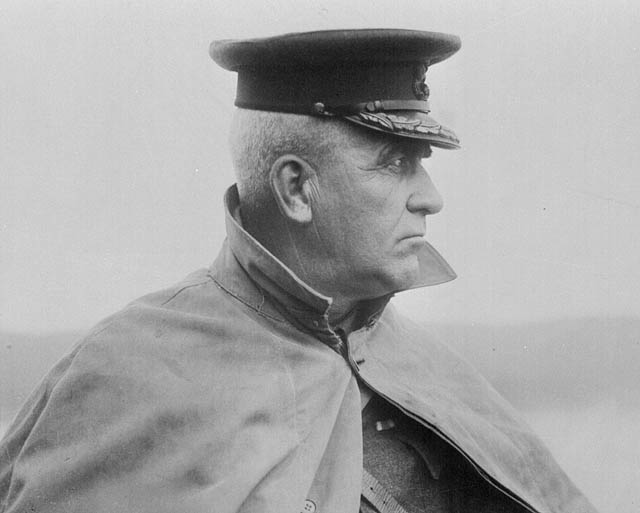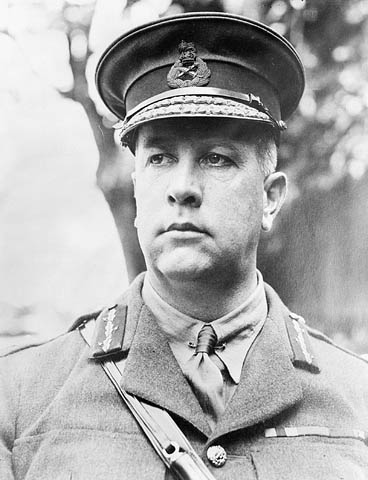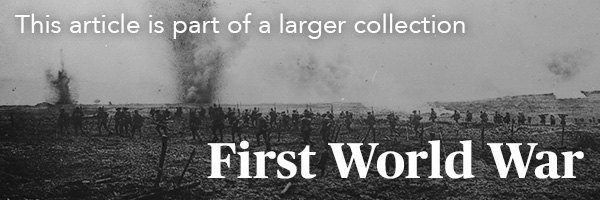The Canadian Expeditionary Force (CEF), of some 630,000 men during the Great War of 1914–18, consisted almost entirely of civilian soldiers. Pre-war farmers, clerks, students, and workers voluntarily enlisted to serve King and Country, although close to 100,000 were conscripted for service in the last year of the war. Most of the Canadian senior officers were drawn from the middle class — lawyers, engineers, professional soldiers, businessmen, farmers, and even a dentist.
![Gen. Sir Sam Hughes and Party looking at ruins in Arras, [France] August, 1916. Gen. Sir Sam Hughes and Party looking at ruins in Arras, [France] August, 1916.](https://d3d0lqu00lnqvz.cloudfront.net/media/vimy_foundation/VF1-2/VF2-4.jpg)
One study from mid-1916 found that of 48 senior officers, three quarters were Canadian-born, a far higher percentage than the CEF rank and file, which only reached 51 per cent Canadian-born. The average year of birth for senior officers was 1873, and all had pre-war military experience, having served during the South African War (1899–1902) or in the Canadian militia. This small group of men would lead Canada’s fighting forces in the most costly war the Dominion would ever experience.
Politicized First Contingent
The pre-war militia was formed from units across Canada and there were over 100 infantry battalions on the Militia List as well as additional artillery and cavalry units. The militia units, usually no more than a few hundred men, marched, trained, and practiced rifle shooting a few times a month. With a professional army of merely 3,100 men before the war, it was the militia, with its part-time soldiers, about 59,000 men on the books in 1914, that was to form the backbone of the defence of Canada — an expeditionary force.

The Minister of Militia and Defence, Sam Hughes, was a critical figure in August 1914, especially in establishing Canada’s new overseas army called the Canadian Expeditionary Force. Hughes, a militia colonel, was an ardent supporter of the militia. He believed that Canadian men had innate skills as hardy northern warriors and would make better soldiers than the professional troops, whom he thought were lazy and unintelligent. Hughes would initially select most of the senior commanders in the CEF, and this core of battalion commanders and brigadiers, most drawn from the militia, formed the nucleus for the massive expansion of the fighting forces. Hughes's bigotry against French Canadians proved that few would rise to senior command positions.
First Generation of Leaders
Hughes’s three most important appointments were the CEF’s three infantry brigadiers: Malcolm Mercer, Richard Turner, and Arthur Currie. Each would command a brigade of four infantry battalions, about 4,000 men in total. All were experienced militia commanders, but none had ever commanded in battle other than Turner, who had been a junior officer during the South African War and won the Victoria Cross, the Empire’s highest award for gallantry.
The brigadiers had little time to train their men during the chaos of Valcartier, Québec, where 35,000 Canadians converged on the army camp in the hope of being sent overseas. But the brigadiers gathered together some experienced staff officers who assisted in the critical, if seemingly mundane, administrative work. These staff officers, later derided by the soldiers because they were not in the front lines battling the enemy, were vital at Valcartier and later, on the Western Front, in ensuring proper training, the efficient movement of men and matériel, and the taking of a commander’s orders and translating them into actionable duties. Because of the technical nature of this work, many of the staff officers were British-born professional soldiers on loan to the Canadians. The Canadian militia and professional soldiers relied heavily on British soldiers during the course of the war, but, as the Canadians matured, they took over command and staff positions.
The first Canadian commander was also a British-born professional soldier. Lieutenant General E.A.H. Alderson was a British cavalry officer called out of retirement, who had commanded Canadians during the South African War. When the First Contingent of 31,000 Canadians arrived in Britain in October 1914, Alderson set about mentoring his brigadiers and battalion commanders. While Alderson wrote critically that many of his officers lacked a “power or habit of command,” surprisingly few were deemed unfit and sent home. Part of the problem was Sam Hughes, who was fiercely loyal to many of the officers he had appointed, and who clashed with Alderson in his desire to exert influence over the CEF. Alderson’s reversal of Hughes’s temperance policy against alcohol in the CEF was just the start of a rocky relationship. Hughes – aided by a cast of cronies in England including Sir Max Aitken and Colonel John Carson, Hughes's special representative in Britain – undermined Alderson at every turn in order to keep control of politically-motivated military appointments.
Trial by Fire
The Canadian Division arrived on the Western Front in February 1915 under command of Alderson and fighting within the British Expeditionary Force. After two months of trench warfare and steady casualties to snipers and shrapnel, the Canadians fought at the Battle of Second Ypres in late April. The Germans unleashed chlorine gas on 22 April and opened a gap in the Allied line, but the Canadians played a critical role in counterattacking and fighting a skilled defensive battle.
Brigadier Turner was condemned for losing control of his forces during the battle, but he was under enormous pressure from the front and there was constant failure in communication, only some of which was his fault. Brigadier Currie fought a better battle, using his forces and reserves wisely, but he too was later criticized for a controversial decision on 24 April to go to the rear to gather reinforcements. Both Turner and Currie might have been fired if they had been in a British division, but Alderson had also shown little brilliance, remaining out of touch far to the rear. The third brigadier, Mercer, had little direct involvement in the battle. Second Ypres was a trial by fire for the Canadians, who suffered more than 6,000 casualties in about a week of fighting. However, the Canadian infantry battalions, artillery batteries, and other formations, like the engineers, had fought well, despite several battalion commanders being killed while leading from the front.
Further battles unfolded at Festubert (May 1915), followed by a summer of trench warfare, at St. Eloi (April 1916) and at Mount Sorrel (June 1916). In this harsh and unforgiving environment, the Canadians learned to survive and adapt to the front.

Canadian Corps
When the Canadian Corps was formed in September 1915, Alderson was given command. Currie became the general officer commanding (GOC) of the 1st Canadian Infantry Division, and Turner received the 2nd. When the 3rd Division arrived in December 1915, Mercer took command, although he was killed half a year later at Mount Sorrel. The Canadian Corps would grow to 100,000 soldiers and four infantry divisions — the largest Canadian formation on the Western Front. There were, however, other formations, such as the Canadian Cavalry Brigade and forestry and railway units, that were not under the Corps’ command structure. All of the Canadian units were part of the Canadian Expeditionary Force.
Arthur Currie and Richard Turner became natural rivals during the war, but this relationship never degenerated into anything more than mild ill will. Both had been appointed by Sam Hughes and remained friendly with the minister for a time, although they were unhappy with his relentless attacks on Alderson, especially after the British general tried to have the failed Canadian-made Ross rifle replaced with the more robust British Lee-Enfield. Hughes, a dominant and increasingly unsteady personality, thought Alderson was incompetent, callous towards Canadian lives lost in battle, and unwilling to promote Canadian interests.
Sir Julian Byng
After the Canadians’ failure at the Battle of St. Eloi in April 1916, where they were soundly trounced by the Germans, Alderson was forced out of command by a scheming Hughes. Command of the Canadian Corps went to the very good British cavalry general Sir Julian Byng. While Byng was initially bewildered at his command, claiming to have never even met a Canadian in his life, he set about forging the Canadian Corps into an effective fighting formation. His casual style fit well with the Canadian soldiers, who liked to see themselves as an unruly rabble of tough northern outdoorsmen and hunters, rather than spit-and-polish soldiers. The inspiring Byng won over his Canucks and soon they took great pride in calling themselves the Byng Boys. Byng also set about cutting Hughes’s political interference with the Corps, especially the minister’s proclivity to foist officers on Byng for promotion, although this was made all the easier after Hughes was removed as minister for gross incompetence by Canadian Prime Minister Sir Robert Borden in November 1916.
“Bungo” Byng was well connected to British royalty and the British commander-in-chief, Field Marshal Sir Douglas Haig, and he proved a keen mentor to his divisional and brigade commanders. Major General Arthur Currie was selected early on as the best Canadian divisional commander, although Turner’s division had fought more effectively during the Battle of the Somme, where the Canadians suffered 24,000 casualties from September to November 1916. At the helm of the 3rd Division was the British professional soldier Major General Louis Lipsett who was well regarded by almost everyone. Only the 4th Division’s commander, Major General David Watson, a former Conservative newspaperman from Quebec City, was seen as weak. Like all the divisional commanders, Watson had risen through the ranks and was a very good battalion commander but only a mediocre brigadier. He proved to be a weak GOC who relied heavily on his most senior staff officer, British professional soldier William Edmund Ironside. It was widely rumoured that it was Ironside who ran the division, and this tough officer would later have an illustrious career in the British army, eventually serving as chief of the imperial general staff.
Lieutenant General Byng led the Canadians at the Battle of Vimy Ridge in April 1917 — a major victory that captured a seemingly impregnable German position. In June 1917, he was elevated to command the British Third Army and he selected Arthur Currie as his successor. Turner had moved, half a year earlier, to the key position of chief of staff in England, where he was effective in overseeing training, manpower, discipline, morale, and even diplomatic relations with the British civilian and military high commands. Turner was also the military representative at the new Ministry of Overseas Military Forces of Canada which was established in late 1916 as a new political body to oversee the administration of the Canadian Expeditionary Force within the British war effort. Lieutenant General Turner is largely forgotten by Canadians, but he played a key role during the war and afterwards in support of Canadian veterans.
Arthur Currie
The prize of the Canadian Corps went to Currie. The Canadian general, who stood almost 6 feet 3 inches tall and bulged his uniform at over 250 pounds, had an agile mind and was continually studying the challenges of trench warfare. He gathered together an effective staff and encouraged learning from victories and failures in battle. While Currie reported upwards through an army commander to the commander-in-chief of the British Expeditionary Force, Sir Douglas Haig, he was also the Canadian government’s military representative at the front and did not hesitate to exert moral courage in questioning orders from the British that he believed would damage his Canadian Corps. At the Battle of Hill 70, in August 1917, for instance, Currie radically changed the plan of attack from a frontal assault into the French city of Lens to a more sophisticated “bite, hold, and destroy” operation directed at the heights of Hill 70 to the north of the city. A few months later, as the British were scrambling to find ways to deal with a shortage of reinforcements, Currie refused to allow his Canadian Corps to be reduced in size to create new units, a courageous move that kept the Corps as an overstrength shock formation.

While some of the senior officers broke down from the accumulated strain of relentless service — and Currie removed three long-serving brigadiers between May and September, 1918 — the commanders were, as a whole, an experienced group that had been forged in battle. One study of 59 Canadian generals in France and England found that 17 were wounded, although only one, Major General Mercer, was killed in battle. A second divisional commander, the long-serving British professional Major General Louis Lipsett, left command of the 3rd Division in September 1918 and was killed while reconnoitring near the front on 14 October.
The Canadian Corps, a homogenous fighting formation in which all four divisions fought together under the command of the Corps umbrella, had numerous advantages over an average British corps. Its semi-permanent nature allowed Currie to marshal resources and firepower. In contrast, British corps had divisions cycle through them, and they suffered from all the challenges of coordinating resources among senior commands that often did not know one another and had not fought together.
Currie’s style of command was to prepare staged battles that employed heavy firepower to crush enemy resistance, knock out enemy guns, and assist the infantry in crossing the kill zone of no man’s land, between the opposing trenches, to meet the enemy in battle. While this top-down approach to battle was fairly rigid, from the midpoint of the war the infantry’s junior and non-commissioned officers were encouraged to fight their way forward, adapt to enemy terrain and strongpoints, and press the attack even when senior officers were killed or wounded. However, communication from headquarters to frontline units remained a problem throughout the war and was a primary factor in many battles failing.
The Hundred Days
Having escaped the German offensives of the first half of 1918 with few casualties, Currie’s Corps was thrown into a series of battles during the Hundred Days campaign, from 8 August to 11 November 1918. It was in these engagements that the German army was defeated in battle after battle. The Canadians spearheaded many crucial attacks: at Amiens, Arras, the Hindenburg Line, and in the final push to Mons. While Currie had always sought to prepare carefully for battles, gathering overwhelming firepower in the form of artillery and machine-gun units, there was no way to mitigate fully the costly frontal attacks against fortified enemy lines. As shock troops thrown into some of the most difficult battles, the Canadians suffered a crippling 45,000 casualties during the Hundred Days campaign.
Even as the Canadians were lauded for their role during the Hundred Days, some of Currie’s own soldiers believed he was a butcher who had sacrificed their lives in futile battles. Currie, the best fighting general ever produced by Canada, would spend several years dealing with what we would now call post- traumatic stress disorder. He fought for his reputation, which was damaged by rumours of his supposed callous ways. Even before the war ended, these rumours were verbalized in a series of high-profile assaults by the disgruntled former minister of militia and defence, Sam Hughes. After Hughes’s death in 1921, the accusations lived on. In 1928, Currie fought a sensational libel court case in Cobourg, Ontario, against a small newspaper that reported the rumours. He won the case but suffered a stroke and never fully recovered his strength. He died in 1933.
Memory
The popular memory surrounding the Great War is that of senior generals and commanders being little more than butchers and bunglers who were unable to adapt to modern warfare. In reality, the Canadian Corps had very fine battlefield commanders. The mixture of pre-war militia and professional soldiers, when forged in battle and guided by British mentors, allowed the best to rise to command. There were no bloodless solutions to fighting on the Western Front, but the Canadians proved to be among the best in the BEF, and much of that credit was due to its intelligent, hard-working, and adaptive senior officers and commanders.

 Share on Facebook
Share on Facebook Share on X
Share on X Share by Email
Share by Email Share on Google Classroom
Share on Google Classroom






